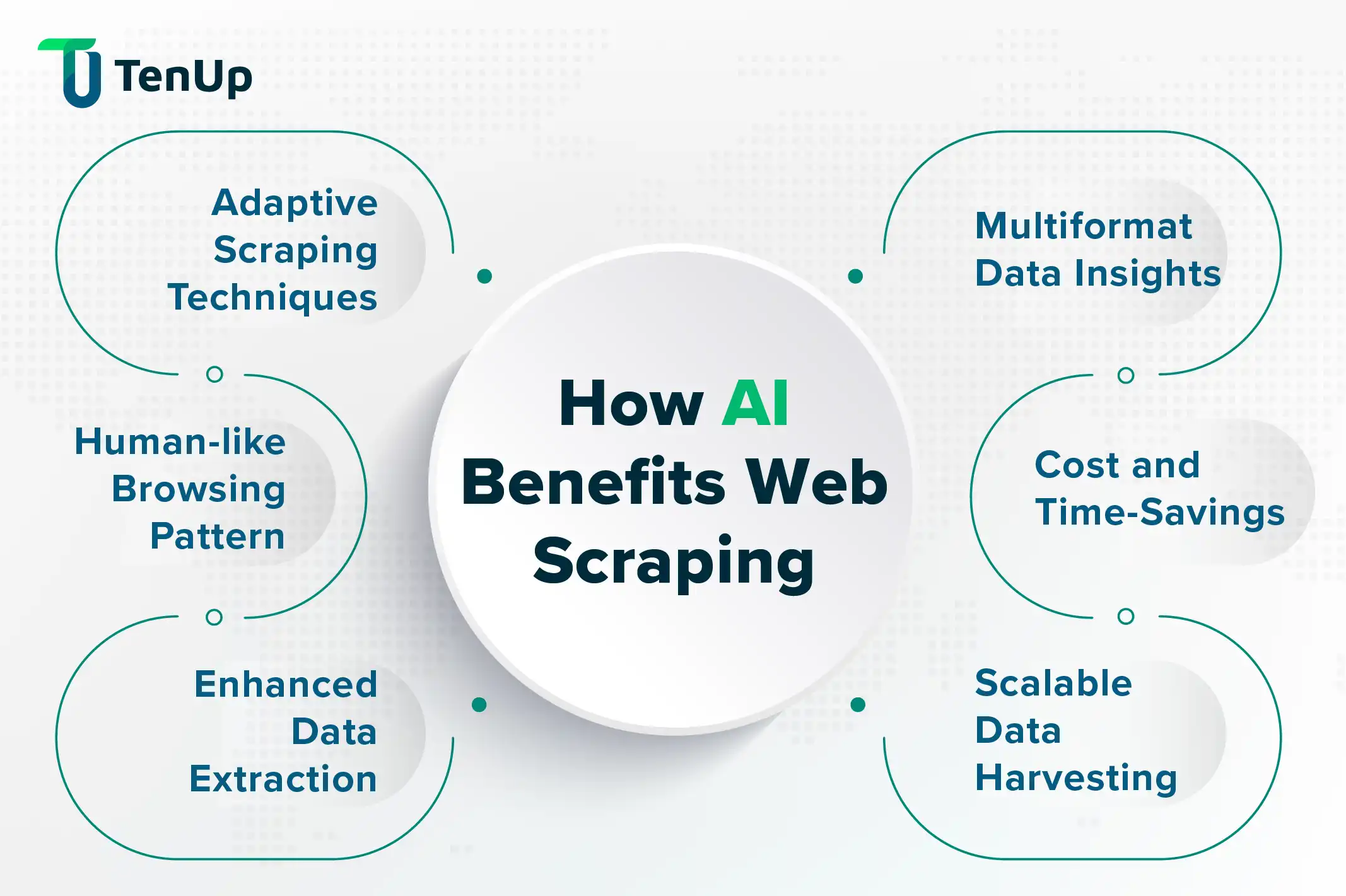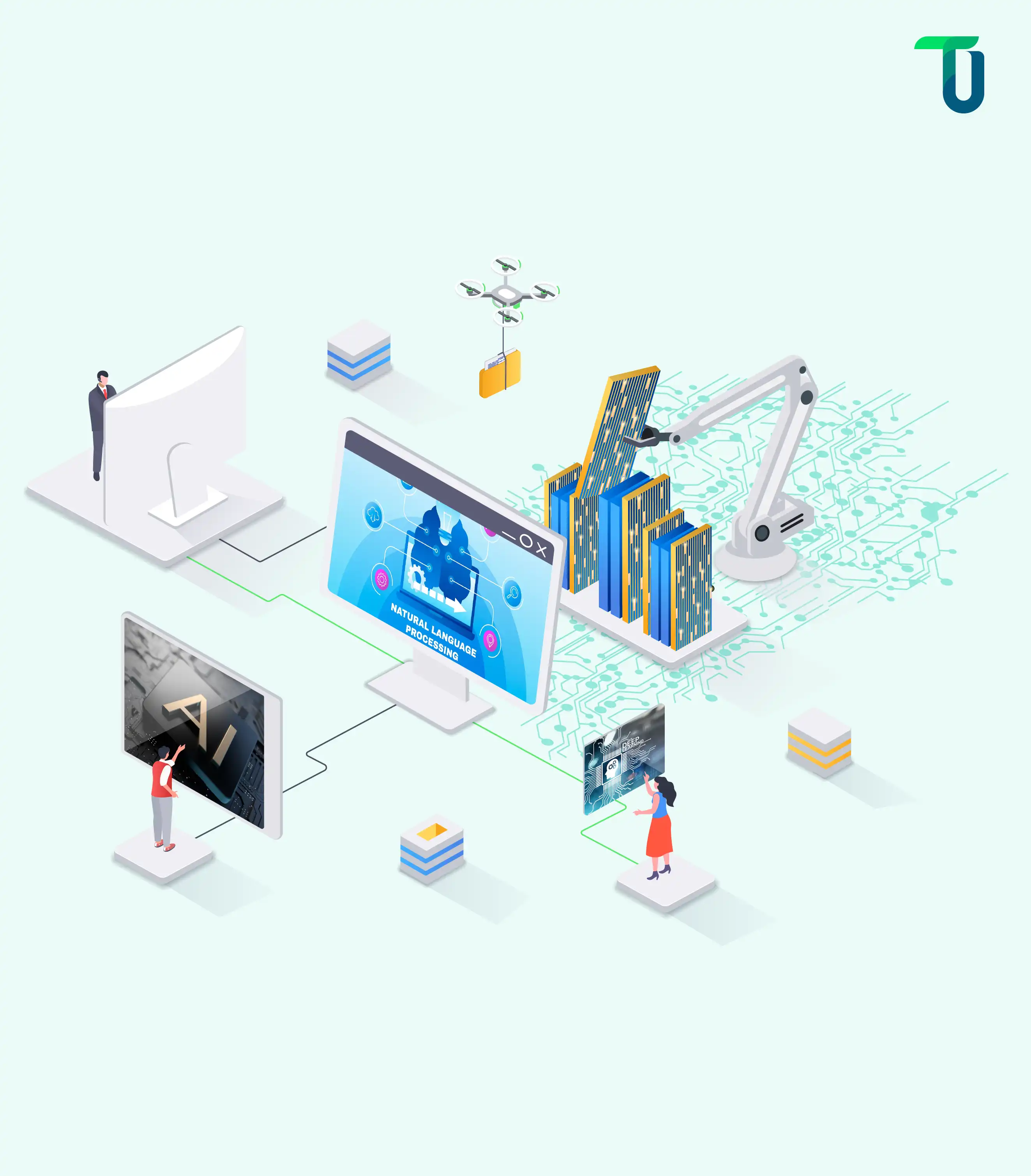What is AI Web Scraping?
AI-powered web scraping is the use of Artificial Intelligence (AI), Machine Learning (ML), and Natural Language Processing (NLP) to extract and process web data efficiently. Unlike traditional methods, AI-driven scrapers adapt to dynamic websites, interpret content contextually, and mimic human-like browsing for accurate and scalable data collection. This technology helps businesses and researchers gather high-quality insights while ensuring ethical and legal compliance. These solutions function as AI website scrapers or AI-powered data extraction tools, enabling faster and more accurate data scraping without heavy coding.
The Evolution of Web Scraping: From Manual to AI-Driven
The origin of Web Scraping can be traced back to the birth of the World Wide Web in 1989. The first web robot (Wanderer), and the first crawler-based web search engine (JumpStation) were released in 1993. At this stage, web scraping was a manual process involving copying data from web pages and pasting it into local databases.
In the second stage of web scraping, data was harvested using simple scripts that parse static HTML pages and extract specific data elements. So, scripting and rule-based systems were built. Beautiful Soup was released in 2004 to pull data from HTML files. These methods worked well with static websites. However, when websites turned dynamic i.e. they changed content frequently and loaded it asynchronously, these methods were unable to adapt to their layout and complex navigation to extract data.
Enter stage three of web scraping. Sophisticated systems capable of navigating complex web architectures were developed. The first such system was Web Integration Platform version 6.0, which was launched in 2006 by Stefan Andresen. It highlighted necessary web page content and structured data in a usable format. It was a visual web scraping software and the foundation for web scraping as we know it now.
Using APIs and RSS feeds, consent-based data scrapers were developed. The advent of Big Data led to the development of web scrapers capable of handling large datasets and enabling data analytics. Integrating Machine Learning (ML) algorithms in web scraping tools increased their capabilities multi-fold in handling complex websites.
This journey brings us to the current stage of web scraping that utilizes advanced AI technologies. Many modern web scraping solutions now integrate agentic AI workflows for autonomous data processes to manage data harvesting tasks autonomously. We’ll discuss this stage in detail in the next section.
How AI Transforms Web Scraping
Advanced AI technologies are taking web scraping to new heights. With Natural Language Processing (NLP), Vision AI, and Deep Learning, web scrapers can better understand the context and interpret content. It leads to better data extraction outcomes. To counteract these intelligence scrapers, new and more complex methods to prevent scraping are being used. This is inspiring the development of new techniques to overcome legal and ethical challenges. Here’s how AI is benefiting web scraping processes and outcomes:

Adaptive Scraping Techniques: Navigating dynamic and complex websites is a key challenge for web scrapers. AI-enabled website scraping solutions using Deep Learning models do not rely on patterns in the layout and structure of the websites. Instead, they parse data more efficiently and understand the context of the content to extract relevant information. They also make relevant decisions while scraping websites to improve the quality of data harvested. This adaptive capability is a hallmark of the best AI web scraper tools, which combine accuracy with scale.
For example, if a business requires competitor product information, an AI-powered scraper will identify a product name on the website even if its location and format change frequently.
Human-like Browsing Pattern: Websites implement anti-scraping measures to prevent automated data mining. They detect the repetitive pattern of traditional scrapers and block them. Gen AI models can be trained to mimic human behavior- their actions and even timing. Using reinforcement learning algorithms, their navigation patterns can be optimized to appear more natural. This reduces their risk of detection for successful data collection. This approach is now standard in advanced AI agent web scrapers that mimic user interaction patterns to bypass detection.
For example, AI-based scrapers showcase human-like behavior and blend in with genuine user traffic to avoid detection.
For data extraction using AI, NLP techniques can be used to train the web scraper to collect data as well as clean and structure it in a usable format. Leveraging AI-first data labeling tools for scalable AI solutions ensures that the structured datasets are accurate and ready for downstream analytics or machine learning models. Returning to our example of gathering competitor product information, NLP-powered scraping solutions identify specific entities, like product names, prices, reviews, etc., from web pages and extract the information systematically to enable analytics. Meaning, web scrapers can be trained for niche AI-based data harvesting tasks.
This helps businesses compare the products of multiple competitors on key parameters and make informed decisions. To derive valuable insights into customer preferences and understand how they feel about the products in question, sentiment analysis can be applied to the scraped data just like we enabled in our Android inventory app to study user shopping behavior and consumption patterns.
Multiformat Data Insights: Using Vision AI techniques for web scraping automates the extraction and analysis of visual content like images and videos. Many AI web scraping tools now include built-in AI-powered data extraction modules for processing visual and textual content together. Custom vision models can be built and trained for a variety of use cases. They can recognize and classify images, extract text from photos using OCR, detect objects and sentiments within visuals, and perform visual searches. These capabilities enable more comprehensive data collection and deeper insights.
Suppose you are an e-commerce company wanting to aggregate a product catalog after careful competitor analysis. You can use Custom AI web scraper for e-commerce to scrape multiple websites, extract product images, analyze attributes like color, style, and brand logo recognition, and gather pricing information. This thorough data collection and analysis helps you make informed strategic decisions.
Cost and Time-Saving Solutions: Custom-built intuitive AI data scraping platforms come with easily understandable dashboards and reports, and their workflows and operations are simple. These AI data scraping tools are designed for both technical and non-technical teams. So, you need not employ data specialists or coders. Your non-technical staff can do the job effectively. This helps optimize your research and resource budgets bringing cost efficiencies.
Besides, AI-powered scraping tools save time by processing data much faster, especially in real-time lead generation workflows for B2B teams . They adapt to different web environments to carry out the scraping process effectively. These tools handle huge volumes of data accurately and automate operations. This helps your resources working on data mining projects improve outcomes by focusing on strategic thinking and creativity.
Scalable AI Data Harvesting: As AI brings adaptive scraping techniques and human-like browsing patterns, provides multiformat data insights, and improves the quality of outcomes while saving time and cost, it improves the scalability of data harvesting manyfold. Such scalability makes AI data scraping essential for enterprises with high-frequency data scraping needs.
Custom-built fine-grained AI models can manage user-specified tasks like analyzing competitor pricing with precision. AI algorithms can crawl hundreds of web pages simultaneously while applying the extraction logic to complete user-defined tasks. AI helps reduce human intervention by automating the rule-creation process and streamlining the data extraction processes, resulting in high scalability.
Benefits of Web Scraping With AI
AI-powered web scraping is revolutionizing how businesses collect and process online data. By combining machine learning models with automated data scraping workflows, companies can achieve levels of accuracy, speed, and cost-efficiency that were impossible with manual or traditional methods.
Accuracy Improvement
AI-powered data extraction tools can identify patterns, understand context, and adapt to site changes, reducing errors that often occur in rule-based scrapers. An AI website scraper can detect and extract the right data even from complex, unstructured sources.
Speed & Scalability
With automated data scraping, organizations can process millions of records in a fraction of the time compared to manual extraction. AI enables near real-time scraping, making large-scale market monitoring or price comparison more feasible.
Real-World Examples
- E-commerce: AI-powered price trackers updating every few minutes.
- Finance: Automated sentiment analysis from global news feeds.
- Research: AI web scraping techniques for lead generation and competitive analysis pulling fresh market intelligence daily.
Whether you’re in retail, finance, or research, the benefits of web scraping with AI extend beyond just faster results — it’s about making smarter, data-driven decisions at scale.
Choosing the Best AI Web Scraper for Your Needs
With so many AI web scraping tools available, choosing the right one can make a significant difference in how efficiently you extract and use data. Whether you’re evaluating AI data scraping tools for e-commerce, research, or competitive intelligence, keep the following criteria in mind:
Speed & Scalability
A best AI web scraper should handle large-scale data collection without slowing down. Look for solutions that support multi-threaded scraping and can process thousands of pages in minutes — a crucial factor when leveraging AI-based data extraction for time-sensitive insights.
Accuracy & Data Quality
The core strength of AI web scraping tools lies in their ability to recognize patterns and extract clean, structured information. Prioritize platforms with built-in error detection, automated validation, and AI-powered content recognition to ensure data accuracy. This directly impacts the benefits of web scraping, helping you make informed decisions with confidence.
Anti-Blocking Capabilities
Websites often use security measures to block automated scraping. Leading web scraping solutions include proxy rotation, CAPTCHA-solving, and human-like browsing patterns to bypass these barriers without interruptions. These anti-blocking measures are essential for advanced web scraping techniques.
Multi-Format Data Support
Your scraper should seamlessly export data in formats like CSV, JSON, XML, or directly into databases and dashboards. Versatile web scraping services make it easier to integrate data into your workflows without extra conversion steps.
When selecting a tool, consider whether you need a cloud-based AI web scraper for accessibility and collaboration or an on-premise setup for greater control and compliance. By weighing these factors, you can identify the best AI web scraper that meets both your technical requirements and business goals.
AI & Web Scraping: The Future of Data Extraction
As discussed, AI integration is the latest evolution in the history of web scrapers. As technology advances, AI-driven data harvesting will witness more automation, better accuracy, and deeper insights. Businesses will continue to identify and grab opportunities with data-driven decisions. However, it is critical to consider ethical scraping practices and comply with legal and ethical standards. So, you need custom web scraping solutions driven by the latest techniques and best practices. As this technology matures, AI data extraction tools will play a major role in automated data scraping, enabling businesses to scale data harvesting without proportional resource costs.
We specialize in building personalized Artificial Intelligence Solutions to solve our client's issues. We can help you attain flexible, efficient, and accurate data collection processes by using Generative AI.
Explore our case study in the fishing industry, where we combined Gen AI techniques and Web Scraping to automate the processes of extracting, structuring, and storing desired data. We built a mechanism to ensure the processes repeat periodically and maintain the most updated state of data in the database at all times.
We’ve partnered with clients across many industries to build personalized solutions concerning their data collection issues. Let’s schedule a call and discuss how we can help you!
Need web scrapers integrating advanced AI techniques?
We have the skills, experience, and expertise in building high-performing Artificial Intelligence solutions.
Frequently asked questions
What exactly is AI agent web scraping, and how is it different from traditional automation?
AI agent web scraping uses intelligent, self-learning agents that simulate human-like behavior to extract data. Unlike traditional rule-based scrapers that break when a site changes, AI agents adapt using machine learning, NLP, and computer vision, making them more accurate, scalable, and resilient for complex or dynamic websites.
How does AI-powered data extraction improve data quality compared to standard scraping tools?
AI-powered data extraction uses machine learning and NLP to understand the meaning behind data, not just its location. This allows it to adapt to layout changes, filter out irrelevant content, correct errors, and validate results, delivering cleaner, more accurate, and more structured datasets than rule-based scrapers.
Can AI data harvesting tools adapt automatically when the website layout changes?
Yes. Modern AI-powered data harvesting tools use machine learning and natural language processing to recognize patterns and understand content context, not just fixed HTML tags. This allows them to adjust automatically to layout changes, maintain high accuracy, and reduce the need for manual updates.
What are the cost implications of using AI data extraction tools versus manual or code-based scraping?
AI data extraction tools cost more upfront than manual or code-based scraping, but they pay off quickly for large or ongoing projects. They scale effortlessly, adapt to website changes with minimal maintenance, reduce human error, and cut the need for specialist developers, making them more cost-efficient over time.
What ethical safeguards should I use when deploying AI-powered web scraping tools?
Follow site rules, protect privacy, and scrape responsibly. Always respect Terms of Service and robots.txt, avoid collecting personal data without consent, use rate limits to prevent server strain, anonymize sensitive information, and comply with laws like GDPR and CCPA. These safeguards keep your AI web scraping ethical, legal, and trustworthy.
Can I set up automated data scraping with an AI tool without writing any code?
Yes. No-code AI web scraping tools let you extract, schedule, and export data without programming. Platforms like Browse AI, and Octoparse use AI recognition, visual selectors, and automation to make data scraping fast, accurate, and accessible to non-developers.
Which AI website scraper tools are considered the ‘best’ in 2025, and what features should I look for?
Top AI web scrapers in 2025 include Diffbot, Browse AI, Apify, and Octoparse AI Edition. Look for adaptive scraping that adjusts to layout changes, built-in anti-blocking (proxy rotation, CAPTCHA solving), multi-format data export, real-time processing, no-code setup, and compliance tools for ethical use


